

How to Write an Advertisement: A Complete Guide for Students and Teachers
As with persuasive texts in general, advertisements can take many forms – from billboards and radio jingles to movie trailers and pop-ups on your computer.
In this guide, we’ll focus on creating a standard magazine-format advertisement, commonly known as a print ad.
Print ads are text-heavy enough to provide substantial content for students to delve into and practice their skills.
While advertisers increasingly shift toward more trackable and often cheaper digital advertising, the same strategies and techniques remain applicable to both formats.
Likewise, strategies such as emotive language and other persuasive devices are essential when writing ads. Much of the writing advice that follows applies to the other persuasive texts , which can also be found on our site. Be sure to check it out, also.
Let’s explore the structure and persuasive elements that make an advertisement successful. These elements combine to make us think and act favourably about a service or product. So let’s get into it and learn how to write an advertisement.
A COMPLETE UNIT ON ADVERTISING FOR TEACHERS & STUDENTS
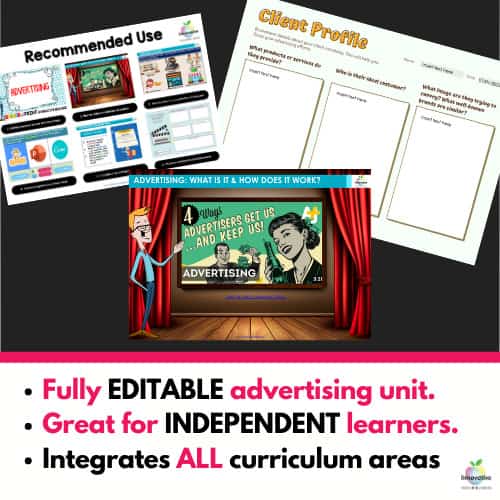
Teach your students essential MEDIA LITERACY SKILLS with this COMPLETE UNIT on ADVERTISING. It’s packed with ENGAGING, INFORMATIVE & FUN activities to teach students the persuasive techniques to READ ADVERTS and the skills to WRITE ADVERTS.
This COMPLETE UNIT OF WORK will take your students from zero to hero over FIVE STRATEGIC LESSONS covered.
PERSUASIVE TECHNIQUES TUTORIAL VIDEO (2:20)
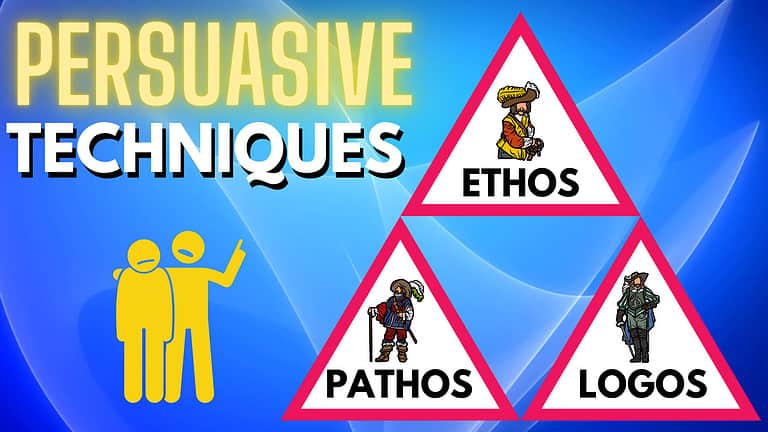
STRUCTURE AND FEATURES OF ADVERTISEMENTS (PERSUASIVE ELEMENTS)
For students to create their own advertisements and successfully employ various persuasive techniques, they’ll first need to develop a clear understanding of an advertisement’s underlying structure.
We’ll explore the primary structural elements and features of advertisements, though the order in which these appear can vary from advert to advert. Here, we’ll take a look at the following persuasive text elements.
- Call to Action

THE BRAND NAME AS A PERSUASIVE ELEMENT

The brand name of the product or service frequently comes at the top of the advertisement – though not always. One of the first tasks for students when writing their own advertisement is to decide on a name for their product or service.
Please encourage students to select a name that reflects the product, service, or values they wish to present to their audience.
Brand names have evolved from being wordy and aspirational to very short and snappy since the inception of the internet, so they can be found easily on a search engine.
BRAND NAME CONSIDERATIONS
- What are the names of similar already existing products or services?
- Does the name look and sound good?
- Is the name short, punchy, and memorable?
- Does it evoke a feeling or an idea?
- Is it distinctive and original?
THE AUDIENCE AS A PERSUASIVE ELEMENT

An advertisement’s target audience may not always be immediately apparent and often needs to be inferred through language and imagery choices made by the writer.
However, who the target audience does need to be decided before writing as it will inform subsequent choices on the use of language (e.g. pronouns, tone, etc.) and imagery.
There are several ways to help students determine their target audience.
A good starting place is to consider creating a target persona—a fictional character who represents the type of person their product or service is aimed at.
- Education level
- Marital status
- Likes/Dislikes
- Who they trust
- What they read/watch
An effective print advertisement presents a product or service in an appealing manner. It quickly conveys essential information about that product or service. It will include a clear and specific offer and also provide the information required for the reader to act on that offer.
Once we have the brand name sorted and the audience defined, it’s time to look at the critical structural elements to consider when writing an ad. It’s important to note that not every element will be used in every ad, but the following model serves well for writing most print advertisements.
THE HEADLINE AS A PERSUASIVE ELEMENT

The ad headline should provide a short, snappy preview of what the reader will find in the copy. A good headline grabs the potential customer’s attention and entices them to read the rest of the ad.
There are several tried-and-tested methods for writing a great headline. Here are three of the most effective:
The Problem/Solution Headline – This headline details a problem a potential customer may be facing and offers the solution in the form of the product or service. For example: Tired? Sluggish? Overweight? Excero Bike Gets You Where You Need to Go, Fast!
The Testimonial Headline – This headline uses a quote from a customer’s positive review to help sell the product or service. The testimonial allows the potential customer to see some ‘proof’ upfront before buying. “With the Excero Bike, I lost 15lbs in 15 days. I’m now thinner, fitter, and much, much happier!”
The Question Headline – This headline asks a question that the target customer will be seeking an answer to, for example, “Are you paying too much for your x?” Are You Paying Too Much for Your Gym Membership?
FREE Advertising Task Matrix
Looking for an engaging way to teach advertising concepts? Download our FREE Bloom’s Taxonomy Advertising Matrix , perfect for empowering students to explore the world of advertising at their own pace. Including activities for analyzing advertisements, evaluating persuasive techniques, and creating original campaigns.

THE LOGO AS A PERSUASIVE ELEMENT
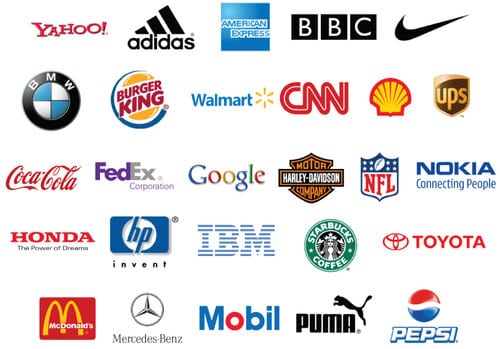
Logos are visual representations of a brand, used to promote a range of products and services under a single umbrella while allowing for quick recognition by the reader.
Though logos are primarily a design element rather than a writing one, they play a vital role in reinforcing brand identity and trust. A well-designed logo communicates the essence of a brand in a single glance, conveying professionalism, reliability, and values.
Logos are especially important in building consistency across various marketing materials, from advertisements to social media posts. They act as a visual anchor, helping consumers associate positive experiences with the brand.
Simple, memorable designs are often the most effective, ensuring the logo remains recognizable across different platforms and formats.
THE SLOGAN AS A PERSUASIVE ELEMENT
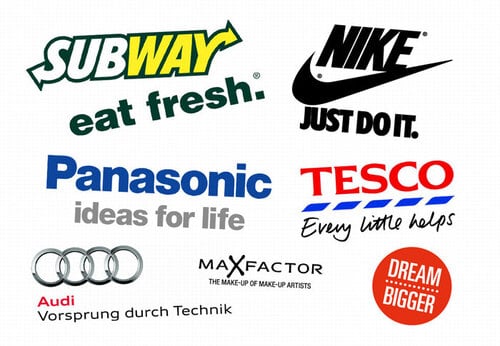
A slogan is a phrase or a short sentence used to represent or sell a particular brand.
Slogans are typically designed to be short and snappy, making them more memorable for readers. They often incorporate figurative language techniques like alliteration, rhyme, or puns to leave a lasting impression.
A well-crafted slogan distills the essence of a brand or product into a few impactful words, creating a connection with the audience and reinforcing brand identity.
Whether clever, emotional, or aspirational, a great slogan helps a brand stand out in a competitive market and stick in the minds of consumers.
THE OFFER AS A PERSUASIVE ELEMENT

A good print ad makes readers an offer. This is usually in the form of a benefit the potential customer will gain or a motivating reason for finding out more about the product or service.
The Offer acts as a ‘hook’ that maintains the reader’s focus and draws them into the body of the ad. It can be a time-limited discount or a 2-for-1 offer, etc. This Week Only – 25% Off!
Offers can also form part of the Call to Action at the end of the ad – more details on this soon.
THE BODY COPY AS A PERSUASIVE ELEMENT
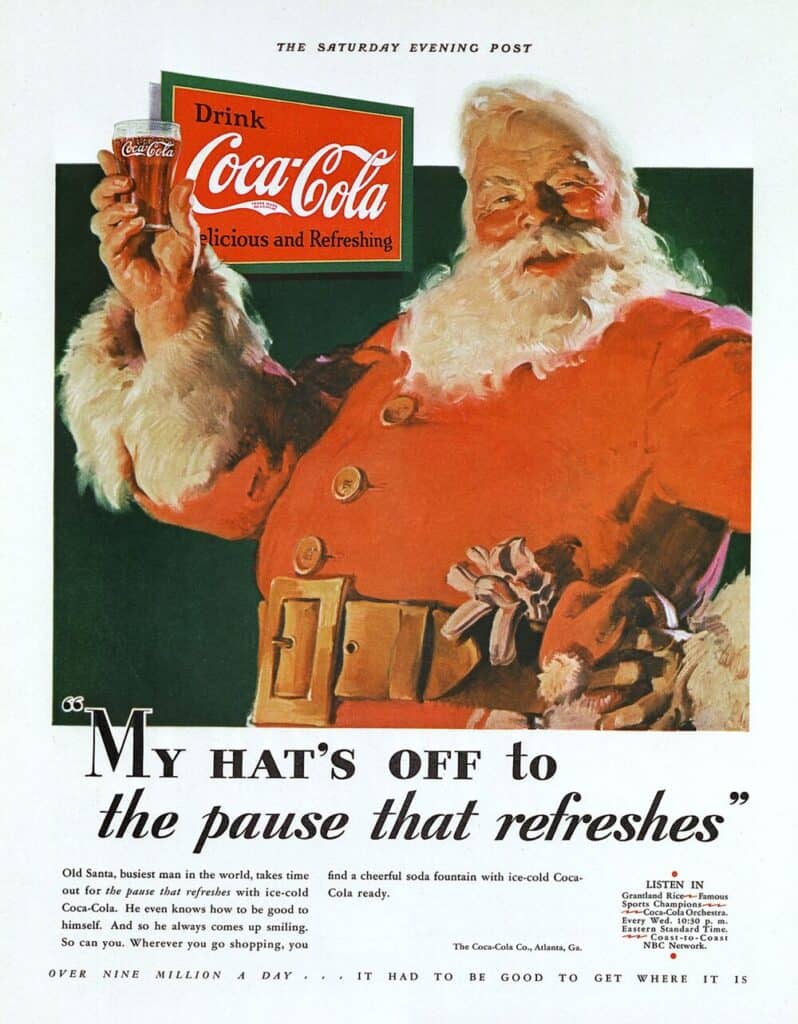
Good body text (or body copy) in an ad is well-organized and quickly gets to the point. Readers want to obtain the necessary information with minimum effort.
For the writer, this requires skill, patience, and much editing. There are several different types of body copy that students need to consider when writing their ads. Let’s take a look at five of these:
Factual – Factual copy gives the reader just enough factual information about the product or service to persuade them that it’s worth buying.
Humor – Using humor is a tried-and-tested means of making an ad memorable. To use it successfully, students will need to have an excellent understanding of their target audience.
Narrative – This copy tells a story as a way to draw the customer in. Many people are resistant to direct selling. Narrative copy uses the power of storytelling to build a connection with the customer to ‘soft sell’ to them.
Testimonial – While testimonial content usually comes from a customer, it can also come from experts, celebrities, or any kind of spokesperson. The testimonial is based on what the customer or spokesperson liked about the product or service.
Testimonials are often woven into the humanity of the ad. This copy appeals to emotions. Rather than boasting directly of the benefits of the product or service, this type of ad evokes the senses and appeals to emotions.
The body copy might include details of available products or services, special offers, or specific information the advertiser wants potential customers to know. Subheadings and bullet points can help organize the text and make information easier to find.
Texts should be short and easy to read. Walls of text can be off-putting; if the language is too complex, it may turn off potential customers.
THE CALL TO ACTION AS A PERSUASIVE ELEMENT

The Call to Action or CTA frequently comes at the end of the advertisement. It’s usually made up of a few sentences that invite the reader to take a specific action. This action might take the form of buying the product, sharing contact information, or, in the case of an online ad, clicking on a link to find out more about the product or service.
Call to action Contexts:
- An electronics company encouraging readers to buy their new computer
- A helpline requesting readers to call a number
- A political party urging readers to vote for them in an upcoming election
- A travel agent appealing to readers to book
- A travel agent appealing to readers to book their next holiday through them
There are many ways to write a CTA but some effective strategies that are commonly used include:
- Start with strong action words urging the reader to take action, e.g. Join, Discover, Order, Subscribe, Buy , etc.
- Let the reader know precisely what you want them to do.
- Ensure the necessary contact details are included, e.g. address, email, website address, phone numbers, etc.
- Motivate the reader to take action through the use of promotional offers, e.g. Get 50% off or Book your free consultation today!
- Provide a reason to take action by communicating the benefits, e.g. Losing weight, Saving money, Performing better, etc.
- Use numbers to appeal to the reader, e.g. Save 20% on your next video, Now with 33% extra free! etc.
- Make your audience an offer they can’t refuse, e.g. Book Your School Marketing and Promotion Analysis today – No Strings Attached.
- Create a sense of urgency by limiting a special offer in some way, e.g. 25% off for the first 100 customers, Free T-shirt if booked today, Buy 2 get 1 free this month only , etc.
PERSUASIVE DEVICES
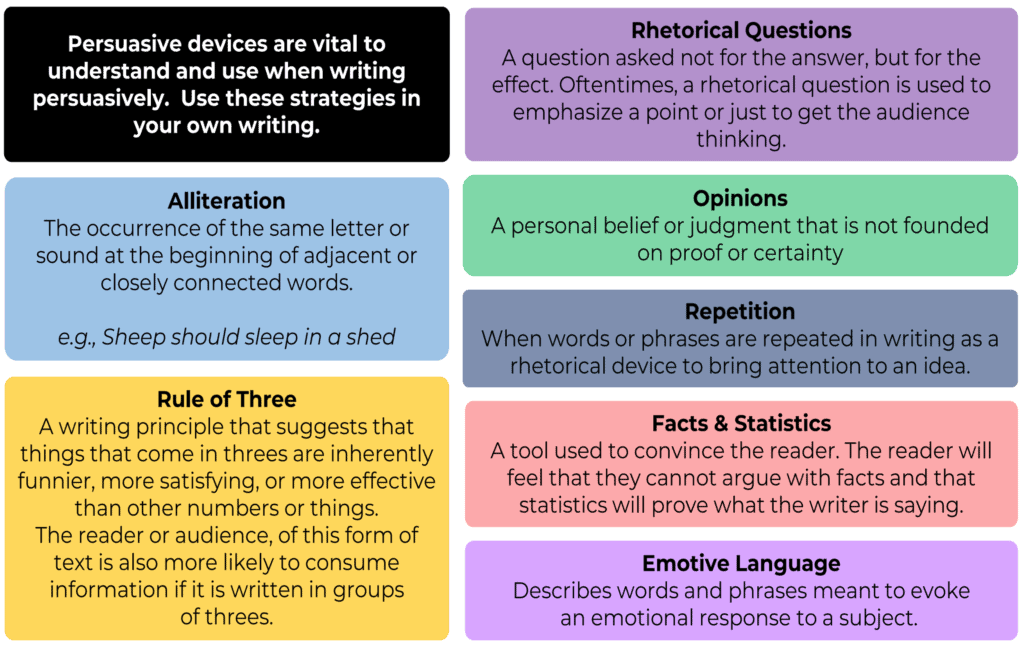
The use of persuasive devices is an essential aspect of writing an advertisement. Our students must clearly understand the following strategies to confidently produce an advertisement that works.
ALLITERATION IN ADVERTISING
This is a literary device that involves the repetition of the initial letter or sound of consecutive words or words near each other. It’s more commonly associated with poetry than nonfiction text types; however, it is also a popular technique used in advertising. Alliteration can help make brand names more memorable. Examples abound, e.g. PayPal, Coca-Cola, Range Rover, and Krispy Kreme, to name but a few.
It’s not just in company names that you’ll find alliteration at work, though. We can also see alliteration alive in slogans such as:
The best four by four by far – Land Rover
Made to make your mouth water – Opal Fruits
Greyhound going great – Greyhound
Don’t dream it. Drive It. – Jaguar
EMOTIVE LANGUAGE
Using emotive language involves deliberately choosing words to provoke an emotional response in the reader. Different ways exist to express the same idea.
We can choose to put a positive, neutral, or negative spin on the same event through the words we select. For example:
Positive: She triumphed gloriously against stiff competition in the spelling bee.
Neutral: She won the spelling bee.
Negative: She received first prize in the poorly attended minor-league spelling bee.
Asking questions can help to engage the reader and persuade them to come to the desired conclusion by themselves. This is the ad equivalent of the ‘show, don’t tell’ mantra employed by fiction writers.
As with all techniques and strategies, this must be used carefully. If used carelessly, it can have the opposite of the desired effect, such as building resistance in the reader.
Students should avoid making hyperbolic suggestions with their rhetorical questions. For example, the question, “Want to lose 50 lbs in 2 weeks?” implies a highly exaggerated claim that most intelligent readers will not believe. In this instance, the rhetorical question detracts from the ad’s effectiveness rather than enhances it.
The most important thing for students to remember when using this technique is that they should only ask rhetorical questions in their ads when they can predict with a reasonable degree of certainty what the answer will be in the reader’s mind.
Nine times out of ten, that answer should be a simple “yes.” Questions should be straightforward, as should the answers they generate.

Advertisers know that we usually need to see or hear things several times before we’ll remember them. Also, the reader is more likely to believe something true the more frequently they hear it. For these reasons, advertisements rely heavily on repetition to drive their message home.
In advertising, the repetition of certain keywords or phrases is used to emphasize a specific idea or emotion. When used well, it can increase the overall effectiveness of an ad. However, students should be careful not to bore the reader. Repetition should always be used strategically.
Repetition doesn’t just involve the repeating of words. It can also include repeating colors and images.
Here are some examples of repetition at work.
ADVERTISING WRITING TIPS FOR STUDENTS
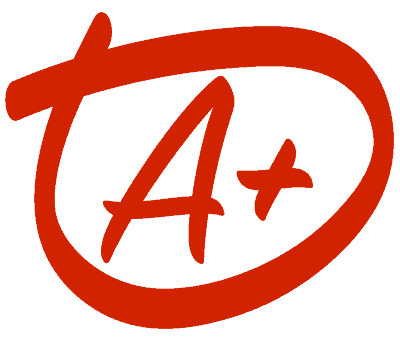
- Carefully Consider the recount TYPE and AUDIENCE before writing.
- Keep the title simple, e.g. My First Day at High School
- Organize the text using paragraphs, e.g. a new paragraph for each section. Use the first orientation paragraph to set the scene by introducing characters, setting, and context.
- Write the recount in chronological order – the order in which things happened and keep it in the past tense – relating events that have already happened.
- Choose the correct perspective from which to write the recount, e.g. personal recounts will be told from a first-person perspective (e.g. I, me, etc.). Factual recounts are most often told from the third-person perspective (e.g. she, he, they, etc.).
- Use time connectives to help organize the text and link the different sections of the recount together.
- Avoid repetitive use of language like then x, then y, and then z.”
- Aim to draw the reader into the action by using descriptive and figurative language
- Focus on the most critical/exciting parts.
- Use plenty of detail but ensure it is relevant to the purpose of the recount.
PERSUASIVE VOCABULARY
Vocabulary can elicit an emotional response beyond the literal meaning of the words used. When students understand this, they understand a powerful tool of persuasion.
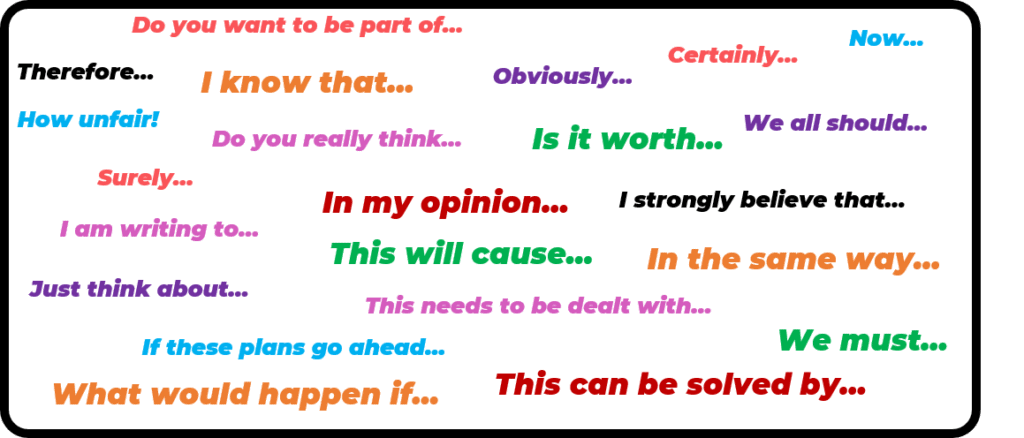
PERSUASIVE ADVERTISING STRATEGIES

The Pain Solution: Persuades by highlighting a problem and suggesting a solution.
The Bandwagon: Persuades to do, think, or buy something because it is popular or because “everyone” is doing it.
The Testimonial: Persuades by using a previous customer or famous person to endorse a product or idea.
The Logical Appeal: Persuades by using reason, usually in the form of a claim backed by supporting evidence.
The Emotional Appeal: Persuades using words that appeal to emotions instead of logic or reason.
The Youth Appeal: Persuades by suggesting you’ll feel younger and more energetic using this product or service.
The Romantic Appeal: Persuades the reader by invoking the powerful and inspiring feelings of love.
The Empathy Appeal: Persuades the reader by encouraging them to identify with the plight of another.
The Testimonial: Persuades the reader by using a previous customer or famous person to endorse a product or idea
THE ROLE OF IMAGES IN AN ADVERTISEMENT

It’s a competitive world out there! Advertisements must catch and hold attention in an overwhelmingly noisy world, and images are a powerful means of doing this. Photos, pictures, diagrams, logos, color schemes – the visual look of an ad is as important as the text and, in some cases, more important!
Interesting images capture interest. They can intrigue the reader and encourage them to read the text they accompany.
Images also help the reader visualize the product or service offered. Advertising space can be expensive, and, as the old adage has it, a picture tells a thousand words. Images help advertisers make the most of their advertising real estate.
Students should carefully choose (or create) images to accompany their text. They should ensure that images are relevant and appropriate for their selling audience. They should look natural and genuine rather than posed.
Students can create their own images using their cell phones or graphic designer apps such as Canva .
This is our complete guide on writing an advertisement for students, and be sure to browse all our persuasive articles whilst you are here. Finally, we also have a complete unit of work on advertising for students and teachers that can be found here.
PERSUASIVE DEVICES TUTORIAL VIDEO
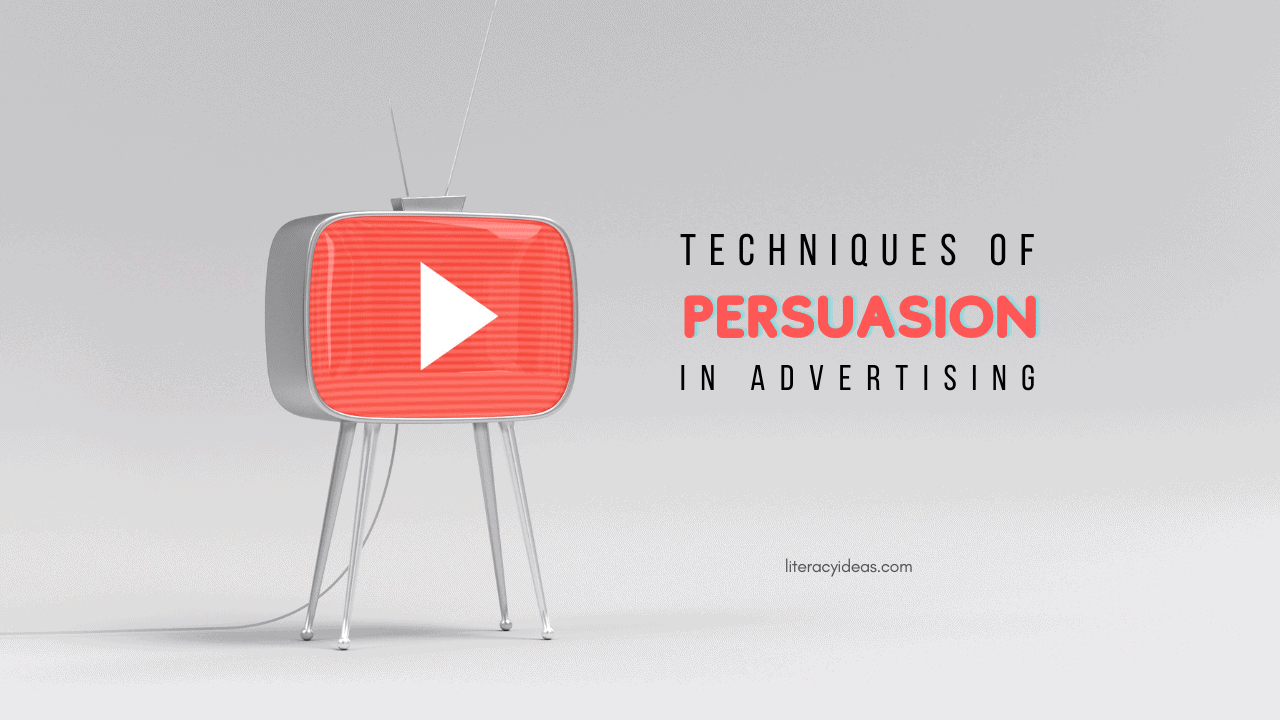
OTHER ARTICLES RELATED TO HOW TO WRITE AN ADVERTISEMENT
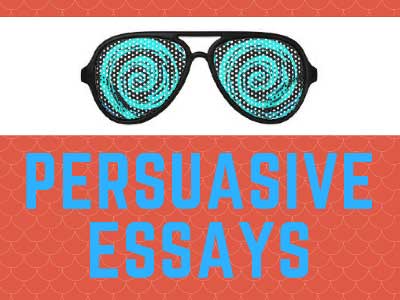
How to Write Perfect Persuasive Essays in 5 Simple Steps
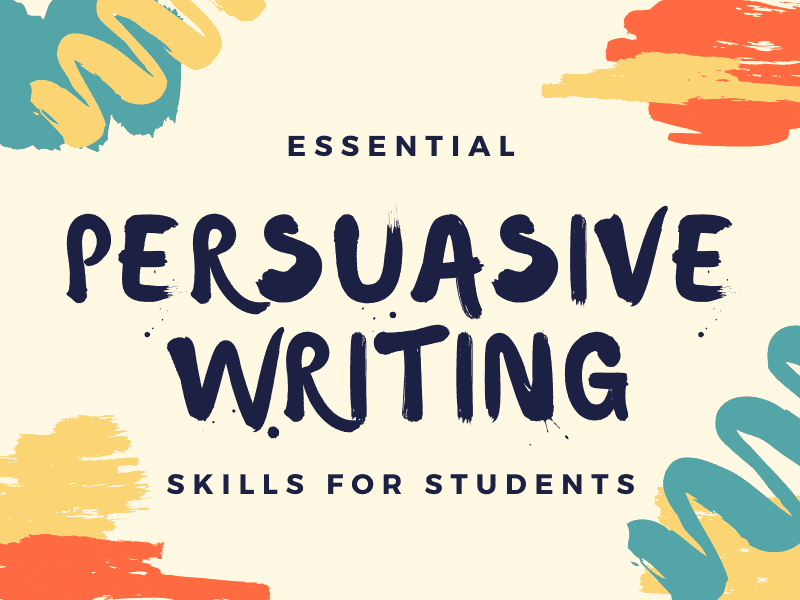
Top 5 Persuasive Writing Techniques for Students
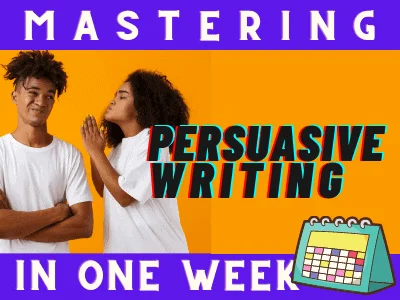
5 Top Persuasive Writing Lesson Plans for Students and Teachers
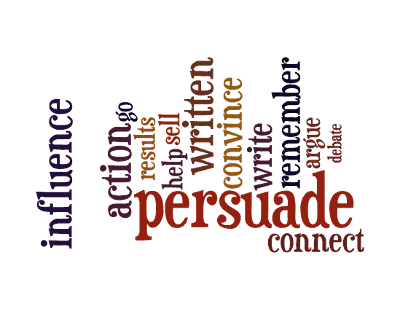
23 Persuasive writing Topics for High School students

Teaching Fact and Opinion
Please log in to save materials. Log in
- Resource Library
- Advertisements
- Advertising Techniques
- Commercials
- Language of Persuasion
- Media Literacy
- Media and Information Literacy

Education Standards
Michigan state ela standards.
Learning Domain: Reading for Informational Text
Standard: Determine the meaning of words and phrases as they are used in a text, including figurative, connotative, and technical meanings; analyze the impact of a specific word choice on meaning and tone.
Learning Domain: Writing
Standard: Write routinely over extended time frames (time for research, reflection, and revision) and shorter time frames (a single sitting or a day or two) for a range of discipline-specific tasks, purposes, and audiences.
Standard: Gather relevant information from multiple print and digital sources, using search terms effectively; assess the credibility and accuracy of each source; and quote or paraphrase the data and conclusions of others while avoiding plagiarism and following a standard format for citation.
Advertising Techniques Packet
Analyze and advertisement mini-poster project, language of persuasion presentation, lesson plan 3- advertising techniques- the language of persuasion, name that technique, technique review, weasel words presentation, lesson 3: advertising techniques- the language of persuasion.
Students will use the Five Core Concepts and Five Key Questions to analyze and evaluate media messages. These concepts will serve as the "Big Ideas" or the "Enduring Understanding" that students will need in order to become media literate.
Students will learn the Language of Persuasion used in advertising, specifically techniques that appeal to pathos (emotion), logos (logic), and ethos (credibility/character). They will use these techniques to analyze both print advertisements and television commercials. The lesson will culminate in the analysis of advertisements and the various techniques that they use as well as an evaluation of their effectiveness.
This is Part 3 of a 5 Part Unit: Media Manipulation: What Are They Really Saying?
Students were given the Advertising Packet in Lesson 2 of this Unit (Fact vs. Opinion) and should have completed page 2.
Read the “History of Advertising” in Advertising Packet (pages 3-4). Choose a reading technique to use while reading (popcorn, jigsaw, Talk To The Text). The article contains important vocabulary as well as explaining how the business of advertising works.
Students will then complete page 5 their knowledge of logos and slogans which makes a text-to-world connection.
Share some time with students sharing the slogans/jingles that they remember (this will be a fun activity). Lead a class discussion:how do you remember the slogans/jingles? What makes a good slogan/jingle?
Optional: play a game! Name that product, jingle game. Create your own or use this video: https://www.youtube.com/watch?v=GjI_aP0tCHI
Optional: play classic jingles (Oscar Meyer, Coca Cola). These are easily found on YouTube.
As a cute ending of the lesson, watch the commercial scene from the movie Inside/Out https://www.youtube.com/watch?v=SRoP4AN-cN4
You were given the Advertising Packet in Lesson 2 of this Unit (Fact vs. Opinion) and should have completed page 2 already.
Read the “History of Advertising” in Advertising Packet (pages 3-4).
Complete page 5 using your knowledge of logos and slogans.
Share some slogans/jingles that youremember (this will be a fun activity). Think: how do you remember the slogans/jingles? What makes a good slogan/jingle?
Begin by asking students if any of the jingles from yesterday were stuck in their heads? How do they think that happend?
Read Page 6 in the Advertising Packet about Consuming Ads. Students will need to brainstorm about all of the places they encounter advertisements/commercials.
Is Seeing Believing? Advertising Packet Page7- Watch the videos and write 3 things that you learned from each video. Students can watch them as a class and Turn and Talk to brainstorm what they learned or they can watch them individually on a personal device. Links:
Food Ad Tricks: Helping Kids Understand Food Ads on TV https://www.youtube.com/watch?v=fUjz_eiIX8k
Tricks Advertisers Use To Make Food Look Delicious! DIY Food Photo Hacks and More https://www.youtube.com/watch?v=MflT0I7ZPCs
29 COMMERCIAL TRICKS WE ALWAYS BELIEVED https://www.youtube.com/watch?v=gQzcno9r1OQ
Superhuman Tape Measure Skills DEBUNK https://www.youtube.com/watch?v=rsXQInxxzBU&t=584s
Skiing Ostriches DEBUNK (Featuring the YouTube Algorithm) https://www.youtube.com/watch?v=H_slT5YpBok
Were any of the jingles from yesterday were stuck in your head? How do you think that happend?
Read Page 6 in the Advertising Packet about Consuming Ads. You will need to brainstorm about all of the places you encounter advertisements/commercials.
Is Seeing Believing? Advertising Packet Page7- Watch the videos and write 3 things that you learned from each video. You can watch them as a class and Turn and Talk to brainstorm what you learned or you can watch them individually on a personal device. Links:
Class discussion:
What are your favorite commercials? Why?
How do ads work?
What is the purpose of ALL advertisements?
What are the ones that work best on you on you?
Introduction to Ethos/Pathos/Logos. Packet Page 8. Explain to students that these 3 techniques have been used for centuries to persuade. These are techniques they use themselves when trying to persuade someone (even if they didn’t know they were using them!). Extension: Watch the Ethos, Pathos, and Logos by Studio Binder. https://www.youtube.com/watch?v=lmR58_dqLxY
Begin the Introduction of the Language of Persuasion. Language of Persuasion Presentation to demonstrate each technique. For each Language of Persuasion students need to categorize it as Ethos/Pathos/Logos (Packet Pages 9-12).
If class time is left over, watch a few commercials (or have students find links to their favorite commercials) and practice identifying the Language of Persuasion used.
Introduction to Ethos/Pathos/Logos. Packet Page 8. These 3 techniques have been used for centuries to persuade. These are techniques you use youself when trying to persuade someone (even if you didn’t know you were using them!). Extension: Watch the Ethos, Pathos, and Logos by Studio Binder. https://www.youtube.com/watch?v=lmR58_dqLxY
Begin the Introduction of the Language of Persuasion. Language of Persuasion Presentation to demonstrate each technique. For each Language of Persuasion you need to categorize it as Ethos/Pathos/Logos (Packet Pages 9-12).
If class time is left over, watch a few commercials and practice identifying the Language of Persuasion used. Commericials can be found easily on the internet.
Today, students will examine the words used in advertisements and commercials. Just as the lesson started with examining the difference between a fact and an opinion, today they will look at two different techniques that make opinions sound like facts: Puffery and Weasel Words.
Read the top of packet pages 14-15 with students. Check for comprehension by showing advertisements or commercials and asking them to spot the weasel words and puffery. Optional: If students are struggling with comprehension, show the Weasel Words Presentation.
Students are broken into groups and given a magazine (or a curated presentation shared digitally). They will then analyze the ads for Puffery and Weasel Words. Working together they will analyze the words contained in the advertisements for these techniques.
Today, you will examine the words used in advertisements and commercials. Just as the lesson started with examining the difference between a fact and an opinion, today you will look at two different techniques that make opinions sound like facts: Puffery and Weasel Words.
Read the top of packet pages 14-15 with students. Optional: If you are struggling with comprehension, watch the Weasel Words Presentation.
With a partner or in a small group, analyze the ads given to your by your teacher for Puffery and Weasel Words. Working together you will analyze the words contained in the advertisements for these techniques.
Day 7 with Optional Days 8-9
ASSESSMENT: Students will be shown commercials. For each commercial the students will identify the techniques used in each. Then they will evaluate the ad for effectiveness (Pages 16-18). Commercials can be found easily on YouTube.
Day 8-9 (Optional Project/Assessment)
Alone or with a partner (no groups of 3 please) deconstruct an advertisement
using the questions in Analyze an Advertisement Mini-Poster Project document.
Students will choose an advertisement from the stack of available ads and answer the questions in the boxes below using complete sentences, correct spelling, and grammar!
Next, students will cut the boxes out from the document and glue them onto the construction paper with the advertisement.
ASSESSMENT: You will be shown commercials. For each commercial you will identify the techniques used in each. Then you will evaluate the ad for effectiveness (Pages 16-18).
Alone or with a partner (no groups of 3 please) deconstruct an advertisement using the questions in Analyze an Advertisement Mini-Poster Project document.
You will choose an advertisement from the stack of available ads and answer the questions in the boxes below using complete sentences, correct spelling, and grammar!
Next, you will cut the boxes out from the document and glue them onto the construction paper with the advertisement.
Version History
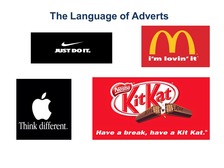
- Number of visits 523
- Number of saves 69
The Language of Advertising: 9 persuasive techniques
- Report this resource
Description

Wyoming Standards for English Language Arts
Learning Domain: Language
Standard: Apply knowledge of language to understand how language functions in different contexts, to make effective choices for meaning or style, and to comprehend more fully when reading or listening.
Degree of Alignment: Not Rated (0 users)
Maryland College and Career Ready English Language Arts Standards
North dakota english language arts & literacy content standards.
Learning Domain: Reading Standards for Informational/Nonfiction Text
Standard: Delineate and evaluate a text’s argumentative reasoning and persuasive techniques, including emotional appeals and establishing credibility.
Common Core State Standards English Language Arts
Cluster: Knowledge of Language.
Evaluations
No evaluations yet.
Tags ( 26 )
- Advertisement
- Persuasive Language Techniques
- Persuasive Techniques for Advertisement
- Reading Activity
- Reading Skills
- Writing Activity
- Writing Skills
- language of advertisement
- Creative Writing
- adverts and slogans
- persuasive language of adverts
- persuasive techniques for ads
- English Language
- English as a Foreign Language
- production of slogans for ads
- critical literacy
- reading awareness
- Close and Critical Reading
- Critical Reading
- activities for writing
- activity to improve writing
- Reading Comprehension
- Reading in EFL
- critical reading activity
Version History
Review Criteria

Advertising Techniques: A Project

Design a Successful Advertisement Assignment: A Step-by-Step Guide
Define your advertisement objectives, identify your target audience, establish advertising goals, determine your unique selling proposition, create your advertisement concept, brainstorm ideas, choose the right ad format, develop visuals and copy, design your advertisement layout, apply layout principles, select a color scheme, choose typography, create your own advertisement assignment, utilize ad creation tools, test different ad versions, gather feedback, measure your advertisement success, identify key performance indicators, analyze results, optimize your ad campaign.
Designing a successful advertisement assignment doesn't have to be an intimidating task. In this step-by-step guide, we will walk you through the entire process to create your own advertisement assignment that will effectively reach your target audience and achieve your advertising goals. Let's dive in!
Before you start designing your ad, it's important to have a clear understanding of what you want to achieve with your advertisement assignment. This involves identifying your target audience, establishing advertising goals, and determining your unique selling proposition.
Knowing who you want to reach with your ad is essential for creating a successful campaign. Consider the following factors when identifying your target audience:
- Demographics: age, gender, location, income, etc.
- Interests: hobbies, preferences, needs, etc.
- Behavior: online habits, purchasing patterns, etc.
Having a clear idea of who your target audience is will help you tailor your ad to resonate with them and increase its effectiveness.
Setting goals for your advertisement assignment will help you measure its success and guide your design choices. Common advertising goals include:
- Increasing brand awareness
- Driving website traffic
- Generating leads or sales
- Encouraging customer engagement
Choose the goals that align with your overall marketing strategy and ensure they are specific, measurable, achievable, relevant, and time-bound (SMART).
Your unique selling proposition (USP) is what sets your product or service apart from your competitors. It's the reason why customers should choose you over other options. To determine your USP, consider:
- What makes your product or service unique
- The benefits your customers will receive
- How your product or service solves a problem or fulfills a need
Once you've identified your USP, make sure to emphasize it in your advertisement assignment to effectively communicate your value proposition to your target audience.
Now that you've defined your objectives, it's time to get creative! In this section, we'll explore how to brainstorm ideas, choose the right ad format, and develop engaging visuals and copy to create an advertisement concept that captures your target audience's attention and achieves your goals.
Before diving into ad design, take some time to brainstorm ideas for your advertisement assignment. Here are some tips to help you get started:
- Think about your target audience's interests and preferences. What type of content would they find appealing?
- Consider your unique selling proposition (USP) and how it can be incorporated into the ad concept.
- Try using mind mapping or free-writing techniques to generate a list of ideas.
- Take inspiration from successful ads in your industry, but remember to put your own spin on it and stay true to your brand.
Don't be afraid to think outside the box—sometimes, the most memorable ads are the ones that break the mold!
There are various ad formats available, each with its own strengths and limitations. When choosing the right format for your advertisement assignment, consider the following:
- Print ads: These include newspapers, magazines, and billboards. They're ideal for reaching a local audience or targeting a specific demographic.
- Online ads: From display banners to social media ads, online advertising offers a wide range of options to reach your target audience on various platforms.
- Video ads: With the rise of platforms like YouTube, video ads are an engaging way to tell your story and showcase your product or service.
- Audio ads: Whether it's a traditional radio spot or a podcast ad, audio ads are a great way to reach people who are on the go or multitasking.
Consider the preferences of your target audience and the nature of your product or service when selecting the most suitable ad format for your campaign.
Once you've settled on an ad format, it's time to bring your advertisement concept to life with compelling visuals and copy. Here's what you need to keep in mind:
- Visuals: Choose images or graphics that are eye-catching and relevant to your product or service. Ensure they align with your brand identity and resonate with your target audience. Don't forget to consider the principles of design, such as contrast, balance, and hierarchy, to create a visually appealing ad.
- Copy: Write clear and concise copy that communicates your unique selling proposition and encourages your target audience to take action. Use persuasive language, but avoid over-hyping your product or service. Remember to include a strong call-to-action (CTA) that tells your audience what you want them to do next.
By combining well-designed visuals and engaging copy, you're well on your way to create your own advertisement assignment that stands out and achieves your advertising goals.
With your advertisement concept in place, it's time to focus on designing an attention-grabbing layout that will showcase your visuals and copy effectively. In this section, we'll discuss how to apply layout principles, select a color scheme, and choose typography to create your own advertisement assignment that stands out and engages your target audience.
To create a visually appealing and functional ad layout, you'll need to consider several design principles. These principles will help guide your design choices and ensure your ad effectively communicates your message:
- Balance: Distribute visual elements evenly across your ad to create a sense of harmony and stability. This can be achieved through symmetrical or asymmetrical layouts.
- Contrast: Use contrasting colors, shapes, and sizes to differentiate between elements and draw attention to key sections of your ad.
- Hierarchy: Organize your ad's elements in a way that guides the viewer's eye through the most important information first. This can be done by varying the size, color, or position of elements.
- Whitespace: Don't be afraid to leave some empty space in your layout. Whitespace can help your ad feel less cluttered and make it easier for the viewer to focus on your message.
By applying these layout principles, you'll be able to create a well-organized and visually striking advertisement that effectively communicates your message to your target audience.
Color plays a significant role in creating an eye-catching and memorable advertisement. When selecting a color scheme for your ad, consider the following:
- Brand consistency: Use colors that align with your brand identity to create a cohesive look and establish brand recognition.
- Emotional impact: Different colors can evoke different emotions in viewers. Choose colors that elicit the desired emotional response from your target audience.
- Contrast: As mentioned earlier, contrast is essential for drawing attention to specific elements in your ad. Make sure your color choices provide enough contrast to make your text and visuals stand out.
By carefully selecting a color scheme, you'll be able to create an advertisement assignment that not only looks visually appealing but also resonates with your audience on an emotional level.
Typography is another crucial aspect of your ad's overall design. The right font choices can greatly impact your ad's readability and aesthetic appeal. When selecting typography for your advertisement assignment, keep these tips in mind:
- Legibility: Choose fonts that are easy to read, especially for the most important information in your ad.
- Font pairing: Use a combination of complementary fonts to create a visually interesting and balanced design. Typically, this involves using one font for headlines and another for body copy.
- Consistency with your brand: Select fonts that are consistent with your brand's identity and messaging to maintain a cohesive look across all your marketing materials.
With the right typography choices, your ad will not only look visually appealing but also ensure that your message is easily understood by your audience.
Moving through these steps, you're well on your way to create your own advertisement assignment that stands out and communicates your message effectively. Remember, a well-designed ad is a powerful tool to engage your target audience and achieve your advertising goals.
Now that you've designed your advertisement layout, it's time to bring your concept to life and create your own advertisement assignment. In this section, we'll cover how to utilize ad creation tools, test different ad versions, and gather feedback to ensure that your advertisement is as effective as it can be. Let's dive in!
Creating your advertisement doesn't have to be a daunting task. Many tools are available that can help you bring your design to life, even if you're not a professional designer. Some popular options include:
- Canva: A user-friendly online design platform where you can create eye-catching ads using customizable templates, graphics, and fonts.
- Adobe Spark: Another online design tool that offers a variety of templates and design elements to help you create professional-looking ads.
- Google Web Designer: A free tool from Google that allows you to create HTML5 ads with animations and interactive elements.
By leveraging these tools, you'll be able to create your own advertisement assignment without having to worry about mastering advanced design skills.
Once you have your ad design, it's important to test different versions of your ad to determine which one performs best. This process, known as A/B testing, involves creating two or more variations of your ad and measuring their performance based on key metrics. To conduct an effective A/B test, consider the following tips:
- Test one element at a time, such as headlines, images, or calls to action, to identify which specific changes lead to better results.
- Run your tests for a sufficient amount of time and ensure that you have enough data to make informed decisions.
- Analyze your test results and implement changes based on your findings. Remember, the goal is to continuously improve your ad's performance.
This process of testing different ad versions will help you optimize your advertisement assignment and maximize its effectiveness.
Finally, don't forget to gather feedback from your target audience. It's essential to understand how your ad is being received and if it's resonating with your audience. Here are some ways to gather valuable feedback:
- Focus groups: Organize a group of people from your target audience and show them your ad. Encourage them to share their thoughts and opinions on its effectiveness, design, and messaging.
- Surveys: Distribute surveys to your target audience asking for their opinions on your ad. This can provide you with quantitative data and specific insights to help you make improvements.
- Social media: Share your ad on social media platforms and monitor comments and reactions. This can give you a real-time understanding of how your audience is responding to your ad.
By gathering feedback from your audience, you'll have a better understanding of what works and what doesn't, allowing you to refine your advertisement assignment and make it even more effective.
With these steps, you're well-equipped to create your own advertisement assignment that stands out and captivates your target audience. Remember, the key to a successful ad is continuous improvement, so don't be afraid to test, gather feedback, and make adjustments as needed. Good luck on your advertising journey!
After creating your own advertisement assignment, the next step is to measure its success. Analyzing your ad's performance will help you understand what's working, what's not, and how you can improve your advertising strategy. In this section, we'll discuss how to identify key performance indicators (KPIs), analyze results, and optimize your ad campaign. So, let's get started!
Key performance indicators (KPIs) are measurable values that help you determine whether your advertisement is on track to achieve its goals. To effectively measure your ad's success, you'll need to identify the most relevant KPIs for your advertising objectives. Some common KPIs include:
- Click-through rate (CTR): The percentage of people who click on your ad after seeing it. A higher CTR indicates that your ad is resonating with your audience and driving them to take action.
- Conversion rate: The percentage of users who complete a desired action after clicking on your ad, such as making a purchase or signing up for a newsletter. This metric helps you understand how effective your ad is at encouraging users to take action.
- Return on ad spend (ROAS): The revenue generated from your ad campaign divided by the amount you've spent on it. This KPI helps you determine whether your advertising investment is paying off.
By focusing on the right KPIs, you'll be able to accurately measure the success of your advertisement assignment and make data-driven decisions to improve its performance.
Once you've identified your KPIs, it's time to analyze the results of your ad campaign. Regularly monitoring your ad's performance will help you spot trends, identify areas for improvement, and make informed decisions about your advertising strategy. Here are a few tips for effective analysis:
- Track your KPIs: Use advertising platforms like Google Ads or Facebook Ads Manager to monitor your KPIs and gather data about your ad's performance.
- Compare results: Look at how your ad is performing compared to previous campaigns or industry benchmarks. This will help you understand whether your ad is meeting or exceeding expectations.
- Identify patterns: Look for trends in your data, such as certain days of the week or times of day when your ad performs better. This information can help you optimize your ad schedule for maximum impact.
By analyzing your ad's results, you'll gain valuable insights into its performance and be better equipped to create your own advertisement assignment that drives success.
Now that you've analyzed the results of your ad campaign, it's time to optimize it for even better performance. Optimization involves making adjustments to your ad based on your findings to improve its effectiveness. Here are some ways to optimize your ad campaign:
- Refine your targeting: If your ad isn't resonating with your target audience, consider adjusting your audience targeting to better reach potential customers who are more likely to be interested in your product or service.
- Test different ad elements: As discussed earlier, A/B testing different versions of your ad can help you identify what works best and improve your ad's performance. Keep testing and iterating to find the most effective combination of visuals, copy, and calls to action.
- Adjust your ad budget: If you find that your ad is performing well, consider increasing your budget to reach more potential customers. Conversely, if your ad is underperforming, you may need to reevaluate your budget and allocate resources more effectively.
Optimizing your ad campaign is an ongoing process that requires regular analysis and adjustments. By doing so, you'll continue to improve your ad's performance and make your advertisement assignment even more successful.
In conclusion, measuring your advertisement's success is a crucial part of the advertising process. By identifying the right KPIs, analyzing your results, and optimizing your ad campaign, you'll be well on your way to creating your own advertisement assignment that achieves your desired goals. Remember, advertising is an iterative process, so keep learning, experimenting, and improving to ensure your ads reach their full potential. Happy advertising!
If you're looking to further enhance your advertising skills after reading our step-by-step guide, don't miss the workshop ' What Makes a Memorable Advertisement? ' by Jessy Moussallem. This workshop will provide you with valuable insights on creating impactful and unforgettable advertisements that will resonate with your target audience.

Live classes every day
Learn from industry-leading creators
Get useful feedback from experts and peers
Best deal of the year
* billed annually after the trial ends.
*Billed monthly after the trial ends.
- Assignment Help
- Assignment Help Online
- Make My Assignment
- Assignment Help Australia
- Write My Assignment
- Do My Assignment
- Writing Assignment for University
- Assignment Writing
- Buy Assignment Online
- Personal Statement Writing
- Narrative Writing Help
- Assignment Paper Help
- College Assignment Help
- Business Plan Writing
- All Assignment Help
- Academic Assignment Help
- Get Assignment Solution
- Powerpoint Presentation Online
- Online Assignment Writer
- Cheap Assignment Help
- Assignment Help Tutors
- Assignment Assistance
- Last Minute Assignment Help
- Urgent Assignment Help
- Assignment Provider
- Pay for Assignment
- Custom Assignment Writing Service
- Quality Assignment Help
- Academic Writing Service
- World No1 Assignment Help Company
- Visa Guide for International Students
- Financial Accounting Assignment Help
- Economics Assignment Help
- Accounting Assignment Help
- Activity Based Accounting Assignment Help
- Cost Accounting Assignment Help
- Managerial Accounting Assignment Help
- Business Accounting Assignment Help
- Solve My Accounting Paper
- Computer Network Assignment Help
- Operating System Assignment Help
- IT Management Assignment Help
- Information Technology Assignment Help
- Competition & Consumer Law Assignment help
- Corporate Governance Law Assignment Help
- Constitutional Law Assignment Help
- Contracts Law Assignment Help
- Commercial Law Assignment Essay Help
- Company Law Assignment Help
- Employment Law Assignment Help
- Business Intelligence Assignment Help
- Business Assignment Help
- Law Assignment Help
- Business Law Assignment Help
- Law Dissertation Sample
- Taxation Law Assignment Help
- Taxation Assignment Help
- Criminology Assignment Help
- Criminal Law Assignment Help
- Management Assignment Help
- Marketing Management Assignment Help
- Strategic Management Assignment Help
- MBA Assignment Help
- Conflict Management Assignment Help
- Change Management Assignment Help
- Operations Management Assignment Help
- Corporate Strategy Assignment Help
- Strategy Assignment Help
- Pricing Strategy Assignment Help
- Marketing Assignment Help
- Strategic Marketing Assignment Help
- Business Development Assignment Help
- Project Management Assignment Help
- 4Ps of Marketing
- Consumer Behaviour Assignment Help
- Bioinformatics Assignment Help
- Biochemistry Assignment Help
- Biotechnology Assignment Help
- Anthropology Assignment Help
- Biology Assignment Help
- Physics Assignment Help
- Chemical Engineering Assignment Help
- Science Assignment Help
- Chemistry Assignment Help
- Environmental Law Assignment Help
- Sports Science Assignment Help
- Political Science Assignment Help
- Mathematics Assignment Help
- Geometry Assignment Help
- Arithmetic Assignment Help
- Trigonometry Assignment Help
- Nursing Assignment Help
- Clinical Science Assignment help
- Pharmacology Course Help
- Mechanical Engineering Assignment Help
- Electrical Engineering Assignment Help
- Civil Engineering Assignment Help
- Psychology Assignment Help
- Social Science Assignment Help
- Public Relations Assignment Help
- Humanities Assignment Help
- Human Resource Assignment Help
- Geography Assignment Help
- Philosophy Assignment Help
- Agroecology Assignment Help
- History Assignment Help
- English Assignment Help
- Finance Assignment Help
- Finance Planning Assignment Help
- Capital Budgeting Assignment Help
- Financial Statement Analysis Assignment Help
- FOREX Assignment Help
- Corporate Finance Assignment Help
- Behavioral Finance Assignment Help
- Arts Architecture Assignment Help
- Arts Assignment Help
- Do My Essay Online
- Essay Outline Help
- Research Essay Help
- Essay Assignment Help
- Essay Editing Services
- Cheap Essay Writer
- Admission Essay Help
- Best Essay Writing Service
- Urgent Essay Help
- College Application Essay
- College Essay Writing Service
- Essay Topics
- Top Essay Writing Companies
- Essay Writers Online
- Evaluative Essay Help
- Responsive Essay Help
- Illustration Essay Help
- Essay Writing Help
- Plagiarism Free Essay
- Custom Essay Help
- Essay Help Online
- Professional Essay Writer
- Write My Essay
- Writing Essay Papers
- Scholarship Essay Help
- Need Help Writing Essay
- Essay Homework Help
- Online Custom Essay Help
- Descriptive Essay Help
- Essay Writer for Australia
- Law Essay Help
- MBA Essay Writing Service
- Business Essay Help
- Nursing Essay Help
- History Essay Help
- Literature Essay Help
- Philosophy Essay Help
- Essay Conclusion
- Essay Proofreading Services
- Dissertation Research Assistance Services
- Dissertation Consulting
- Sociology Dissertation Help
- Dissertation Writing Guide
- Dissertation Abstracts Writing
- Perfect Dissertation Layout
- Dissertation Sample
- Dissertation Writing
- Dissertation Help Online
- Dissertation Services
- Buy Dissertation
- Custom Dissertation Writing Services
- Dissertation Editors
- Dissertation Assistance Services
- Dissertation Experts
- Dissertation Thesis Help
- Dissertation Proofreading Services
- Plagiarism Free Dissertation Help
- Academic Dissertation Help
- Dissertation Writing Company
- Dissertation Proposal Help
- Doctoral Dissertation Help
- Law Dissertation Help
- Marketing Dissertation Help
- Biology Dissertation Help
- Architecture Dissertation Help
- Geography Dissertation Help
- English Dissertation Help
- MYOB Assignment Help
- Case Study Writing Services
- Write my Case Study for Me
- History Case Study
- Case Study Assignment Sample
- Case Study Assignment Help
- Case Study Help
- Amway Case Study Swot Analysis
- Contract Law Case Studies Sample
- Apple Swot & Pestle Analysis
- 4 Step Process Law Case Study
- Coca Cola Swot Analysis Case Study
- Mcdonalds Pestle Analysis Case Study
- Zara Case Study Swot Analysis Solution
- Company Law Case Study
- Case Study on Samsung
- Case Study on Vodafone
- Nike Swot Pest Analysis Case Study
- Ikea Case Study
- Buy Assignment Case Study
- Business Law Case Study
- Legal Case Study Examples
- Civil Law Case Study Help
- Organizational Behavior Case Studies
- Marketing Case Study Help
- Mcdonalds Pestle Analysis Marketing Case Study
- Nursing Case Study Help
- HR Functions Strategy Case Study
- Write My Homework for me
- Homework Writing Service
- Homework Writer
- Homework Help
- Homework Writing Agency
- Buy Homework Online
- Cheap Homework Help
- Homework Help Services
- Do My Homework for me
- PHP Homework Help
- Math Homework Help
- Do My Math Homework
- Algebra Homework Help
- History Homework Help
- Economics Homework Help
- English Homework Help
- Capital Budgeting Homework Help
- Buy Coursework Online
- Custom Coursework Writing Services
- Do My Coursework
- Write My Coursework
- Coursework Help
- Coursework Experts
- Coursework Assistance
- Marketing Coursework Help
- Chemistry Coursework Help
- Maths Coursework Help
- English Coursework Help
- Finance Coursework Help
- Bibliography Maker
- Research Paper Writing Service
- Research Paper Topics
- Ghost Writers
- Research Paper Outline Help
- Custom Writing Service
- College Paper Writing
- Buy College Papers
- How to Write a College Paper
- Writing Services
- Help with Report
- Custom Paper Writing Services
- Paper Writers
- Research Proposal Help
- Story Writing
- Grant Writing
- Thesis Help
- How to Write a Thesis
- Thesis Topics
- Write My Thesis for me
- Thesis Paper
- Thesis Help Online
- CDR Engineers Australia
- CDR for Electronics Engineers
- CDR Report Writers
- CDR Sample on Structural Engineer
- CDR Sample on Mechanical Engineering
- CDR Sample on Biomedical Engineer
- CDR Sample on Telecommunications Engineers
- CDR Sample on engineering Manager Anzsco
- CDR Sample on Transportation
- CDR Sample on Industrial Engineer
- CDR Sample on Electronics Engineer
- CDR Sample on Environmental Engineer
- CDR Sample on Geotechnical Engineer
- CDR Sample on Agricultural Engineer
- CDR Sample on Transport Engineer
- CDR Sample on Electrical Engineer
- CDR Sample on Chemical Engineer
- CDR Sample on Material Engineer
- CDR Sample on Engineering Manager
- Assignment Proofreading Services
- Plagiarism Checker
- APA Referencing
- Chicago Referencing
- Harvard Referencing Generator
- MLA Referencing Generator
- Vancouver Referencing Generator
- Oxford Referencing Generator
- ACS Referencing Generator
- APSA Referencing Generator
- BMJ Citation Style Generator
- Footnotes and bibliography Referencing System
- IEEE Referencing Style Generator
- MHRA Referencing Style Generator
- Citation Generator
- Conclusion Generator
- Thesis Statement Generator
- Essay Topic Generator
- Case Converter Tool
- Alphabetizer
- GPA Calculator
- Title Page Generator
- Writing Prompt Generator
- Resume Builder
- Word Count Tool
- Paraphrasing Tool
- How We Work
- Top Writers
- Our Services
- The Complete Guide to Writing Advertising Assignments: Techniques, and Advice
Advertising is a dynamic and ever-evolving field that plays a crucial role in shaping consumer behavior and promoting products and services. It comes as no surprise that students pursuing degrees in marketing, communication, or business often encounter advertising assignments as a part of their curriculum. These assignments can be both challenging and rewarding, requiring a deep understanding of advertising techniques and effective communication. In this comprehensive guide, we will explore the techniques and advice you need to excel in writing advertising assignments.
Understand the Assignment
The first step in tackling any advertising assignment is to thoroughly understand the requirements. Carefully read the assignment prompt and take note of the specific questions or tasks you need to address. Pay attention to any formatting guidelines, word limits, and deadlines. This initial step is crucial as it lays the foundation for your entire assignment.
Research and Gather Information
Effective advertising is rooted in a deep understanding of the target audience, market trends, and the product or service being promoted. Start your assignment by conducting thorough research. Utilize academic databases, industry reports, and case studies to gather relevant information. Additionally, you can seek assistance from resources such as " All Assignment Help " to find valuable insights and data.
Develop a Clear Thesis Statement
Every great advertising assignment begins with a clear and concise thesis statement. Your thesis should encapsulate the main message or argument of your assignment. It should reflect your understanding of the advertising techniques and strategies you plan to discuss. For example, if your assignment is about the effectiveness of emotional appeal in advertising, your thesis could be something like, "Emotional appeal is a powerful advertising strategy that resonates with consumers and drives brand loyalty."
Analyze Advertising Techniques
Advertising assignments often require you to analyze various advertising techniques and strategies. These may include:
- Emotional Appeal : Explore how emotions are used to connect with consumers on a personal level.
- Persuasive Language : Examine the use of persuasive language and rhetoric in advertising copy.
- Visual Elements : Discuss the impact of visual elements such as imagery, color, and design on consumer perception.
- Target Audience : Analyze how advertisements are tailored to specific target demographics.
- Product Positioning : Explore how products are positioned in the market and the strategies used to create a competitive edge.
Provide Real-Life Examples
To strengthen your arguments and demonstrate your understanding of advertising techniques, include real-life examples in your assignment. These examples could be from well-known advertising campaigns or your own observations. Discuss how these examples align with the techniques you are analyzing.
Use Academic Sources
While real-life examples are valuable, it's essential to support your arguments with academic sources. Cite peer-reviewed articles, books, and scholarly journals to back up your claims and provide a solid academic foundation for your assignment.
Craft Compelling Content
In advertising, the way you communicate your message is just as important as the message itself. Ensure that your writing is clear, concise, and engaging. Use persuasive language and storytelling techniques to capture the reader's attention. Additionally, pay attention to grammar, spelling, and formatting to maintain professionalism in your assignment.
Get Assignment Solution Assistance
If you find yourself struggling with your advertising assignment, don't hesitate to seek help. Online services like " Algebra Assignment Help " can connect you with experts who can provide guidance and assistance in completing your assignment successfully. These services offer valuable insights and support get assignment solution to help you excel in your coursework.
Writing advertising assignment help requires a combination of research, analysis, and effective communication. By understanding the assignment, conducting thorough research, and using the right resources like "All Assignment Help" services, you can enhance your skills and deliver high-quality assignments that showcase your understanding of advertising techniques and strategies. Remember to stay organized, follow the assignment guidelines, and continuously improve your writing and analytical skills to excel in the world of advertising.
GET A FREE INSTANT QUOTE
Thank You For Your Submission!
Follow us on Facebook and Twitter to get regular updates on discount and other exciting offers.
LIKE & Follow
WHAT’S NEXT?
- Fill in the order form. Give precise instructions. No need to pay at this stage.
- Start receiving proposals from our writers within minutes and chat with them live. You still don't have to pay at this stage.
- Ready to select one of the writers? Deposit funds into your BookMyEssay balance so that a writer can work on your order. Attention: You didn't actually pay the writer yet!
- Watch your paper being written and pay your writer step-by-step. You still have full control: you pay only for what has already been completed.
- Get exactly what you needed!
You agree that the papers written by BookMyEssay.com writers are intended to be used only for further individual research, reference or study purposes.

USEFUL LINKS
- Privacy Policy
- Refund Policy

SOCIAL MEDIA
We Write For Following Countries
© 2021 - BookMyEssay.com.au All Rights Reserved


IMAGES
VIDEO
COMMENTS
Students will learn persuasive techniques used in advertising, specifically, pathos or emotion, logos or logic, ... Look for ads that lend themselves well to the assignment, with a balance of text and images and with fairly discernable examples of pathos, logos, and ethos. Consider asking your school library media specialist for issues of ...
Images also help the reader visualize the product or service offered. Advertising space can be expensive, and, as the old adage has it, a picture tells a thousand words. Images help advertisers make the most of their advertising real estate. Students should carefully choose (or create) images to accompany their text.
Create a standalone learning module, lesson, assignment, assessment or activity. Create Resource. Submit from Web. Submit OER from the web for review by our librarians. Add Link. ... Students will learn the Language of Persuasion used in advertising, specifically techniques that appeal to pathos (emotion), logos (logic), and ethos (credibility ...
Persuasive Techniques in Advertising The persuasive strategies used by advertisers who want you to buy their product can be divided into three categories: pathos, logos, and ethos. Pathos: an appeal to emotion. An advertisement using pathos will attempt to evoke an emotional response in the consumer. Sometimes, it is a positive emotion such as ...
Advertising Techniques Assignments. Flashcards; Learn; Test; Match; Q-Chat; Get a hint. Emotional Appeal (need/fear) ... Surrogate advertising is a form of promotion which is utilized to promote items which are prohibited or restricted by promoting beneath government controls, such as cigarettes and liquor through promoting another item ...
Engage students in the analysis of the persuasive written language of advertisements. Students will have to recognize some language techniques used in advertising, match the techniques to some printed ads and create slogans, using such techniques. Subject: English Language, Reading Foundational Skills, Writing Foundational Skills Level: secondary education Material Type: Classroom Activity ...
Advertising Techniques: A project idea for upper elementary and middle school students. Students define each advertising technique and then make their own sample advertisement to demonstrate their understanding of the concept! Blog post includes a free rubric.
Setting goals for your advertisement assignment will help you measure its success and guide your design choices. Common advertising goals include: ... Try using mind mapping or free-writing techniques to generate a list of ideas. ... Remember, advertising is an iterative process, so keep learning, experimenting, and improving to ensure your ads ...
Conclusion. Writing advertising assignment help requires a combination of research, analysis, and effective communication. By understanding the assignment, conducting thorough research, and using the right resources like "All Assignment Help" services, you can enhance your skills and deliver high-quality assignments that showcase your understanding of advertising techniques and strategies.
In this scenario, students will use advertising techniques to create a print advertisement fit for a magazine! Assignment task, details, and rubric assessment are provided. Just print and hand out to students. They really enjoy being able to use their creativity to create an effective ad! I gene...